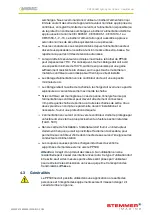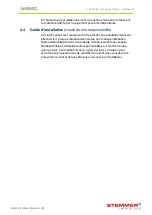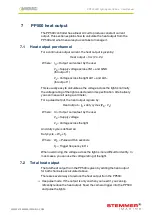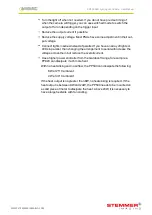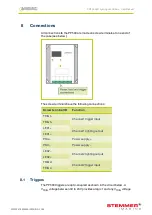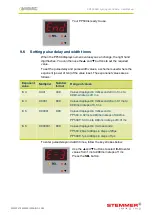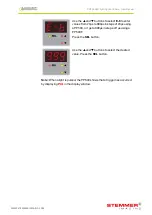
PP500 LED lighting controllers - User Manual
7
PP500 heat output
The PP500 controller has a linear circuit to produce constant current
output. This section explains how to calculate the heat output from the
PP500 and what measures you can take to manage it.
7.1
Heat output per channel
For a continuous output current, the heat output is given by:
Heat output =
I
O
x (V
S
- V
L
)
Where:
I
O
= Output current set by the user
V
S
= Supply voltage across VS1+ and GND
(for output 1)
V
L
= Voltage across the light LD1+ and LD1–
(for output 1)
This is usually easy to calculate as the voltage across the light is normally
the voltage rating of the light as declared in its specification. Alternatively
you can measure it using a voltmeter.
For a pulsed output, the heat output is given by:
Heat output =
I
O
x duty cycle x (V
S
- V
L
)
Where:
I
O
= Output current set by the user
V
S
= Supply voltage
V
L
= Voltage across the light
And duty cycle is defined as:
Duty cycle = W
P
x F
T
Where:
W
P
= Pulse width in seconds
F
T
= Trigger frequency in Hz
When overdriving, the voltage across the light is more difficult to identify. In
most cases, you can use the voltage rating of the light.
7.2
Total heat output
The total heat output from the PP500 is given by adding the heat output
for both channels as calculated above.
There are several ways to reduce the heat output from the PP500:
Use pulse mode. If the output is only on when you need it, you can sig-
nificantly reduce the heat output. Feed the camera trigger into the PP500
and pulse the lights.
—
18
—
PP500 LED lighting controllers - User Manual
Turn the light off when not needed. If you do not have precise timing of
when the camera will trigger, you can use switched mode to switch the
output off or on depending on the trigger input
Reduce the output current if possible.
Reduce the supply voltage. Most PSUs have some adjustment in their out-
put voltage.
Connect lights in series instead of parallel. If you have an array of lights or
LEDs in parallel, then changing the arrangement to serial will increase the
voltage across them but reduce the overall current.
Use a higher power controller from the Gardasoft range, for example a
PP820 can dissipate much more heat.
With no heatsinking and no airflow, the PP500 can dissipate the following:
8W at 25°C ambient
4W at 40°C ambient
If the heat output is no greater than 8W, no heatsinking is required. If the
heat output is between 8W and 24W, the PP500 needs to be mounted on
a solid piece of metal to dissipate the heat. Above 24W, it is necessary to
have a large heatsink with fan cooling.
—
19
—
WWW.STEMMER-IMAGING.COM








